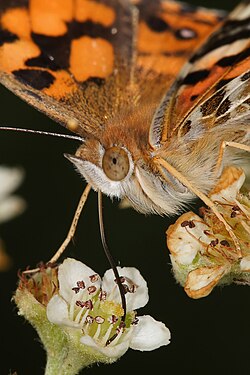
Back راحقة Arabic Антафілія Byelorussian Nektaromanĝulo Esperanto Nectarívoro Spanish شهدخوار Persian Nectarivore French יונקי צוף HE Nektarivor ID Blómsykursæta Icelandic Nettarivoro Italian

In zoology, a nectarivore is an animal which derives its energy and nutrient requirements from a diet consisting mainly or exclusively of the sugar-rich nectar produced by flowering plants.
Nectar as a food source presents a number of benefits as well as challenges. It is essentially a solution of (as much as 80%) the simple sugars sucrose, glucose and fructose, which are easily ingested and digested, representing a rich and efficient source of nutrition. This solution is often diluted either by the plant that produces it or by rain falling on a flower and many nectarivores possess adaptations to effectively rid themselves of any excess water ingested this way.
However, nectar is an incomplete source of nutrition. While it does contain proteins and amino acids,[1] these are found in low quantities, and it is severely deficient in minerals and vitamins.[2] Very few organisms consume nectar exclusively over their whole life cycle, either supplementing it with other sources, particularly insects (thus overlapping with insectivores) or only consuming it exclusively for a set period.[3] Many species are nectar robbers or nectar thieves, performing no pollination while still consuming nectar. Many species are both nectar robbers and pollinators, depending on the plant species they encounter.
Nectar is produced by flowering plants to attract pollinators to visit the flowers and transport pollen between them. Flowers often have specialized structures that make the nectar accessible only for animals possessing appropriate morphological structures, and there are numerous examples of coevolution between nectarivores and the flowers they pollinate. For example, hummingbirds and hawkmoths have long narrow beaks that can reach nectar at the bottom of long tubular flowers.[4][5]
The majority of nectar feeders are insects or birds, but instances can also be found in other animal groups.
- ^ Nepi M, Soligo C, Nocentini D, Abate M, Guarnieri M, Cai G, Bini L, Puglia M, Bianchi L, Pacini E (2012). "Amino acids and protein profile in floral nectar: Much more than a simple reward". Flora. 207 (7): 475–481. doi:10.1016/j.flora.2012.06.002.
- ^ Gartrell B (2000). "The Nutritional, Morphologic, and Physiologic Bases of Nectarivory in Australian Birds". Journal of Avian Medicine and Surgery. 14 (2): 85–94. doi:10.1647/1082-6742(2000)014[0085:TNMAPB]2.0.CO;2. S2CID 86118478.
- ^ Nicolson S, Fleming P (2014). "Drinking problems on a 'simple' diet: physiological convergence in nectar-feeding birds". J Exp Biol. 217 (7): 1015–23. doi:10.1242/jeb.054387. hdl:2263/39829. PMID 24671960.
- ^ Wiens, John A. (1992). The Ecology of Bird Communities: Processes and variations. p. 336. ISBN 9780521426350.
- ^ Richard, A.J. (1997). Plant breeding systems (Second ed.). Chapman & Hall. ISBN 978-0-412-57440-5.
© MMXXIII Rich X Search. We shall prevail. All rights reserved. Rich X Search